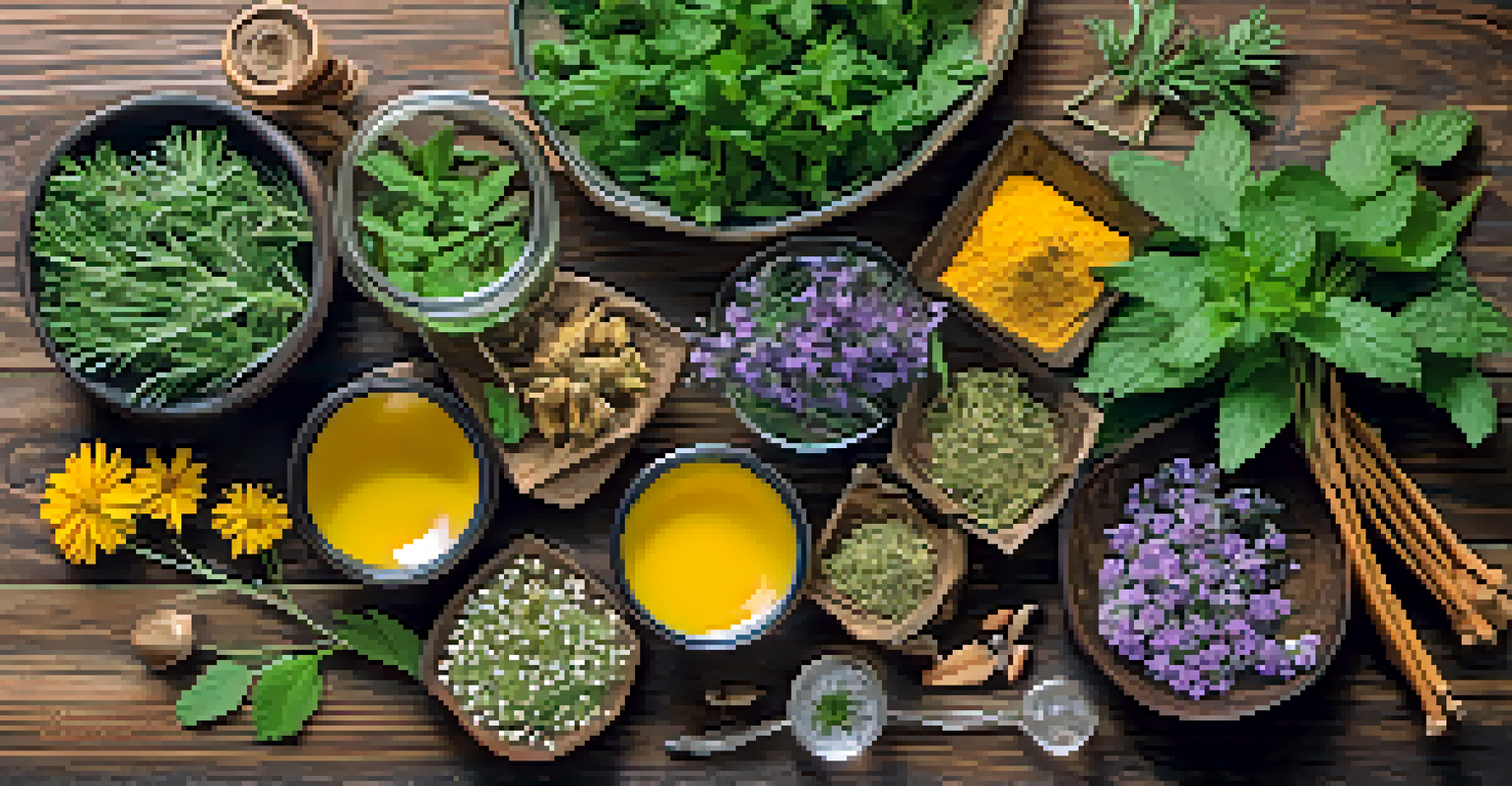The Influence of Nature in India's Traditional Healing Practices

Understanding Traditional Healing Practices in India
Traditional healing practices in India, such as Ayurveda and Siddha, have deep roots in the country's history and culture. These methods emphasize a holistic approach, focusing on the balance between body, mind, and spirit. Practitioners believe that health is not just the absence of illness but a harmonious state influenced by various factors, including nature.
The greatest medicine of all is teaching people how not to need it.
At the heart of these practices is the understanding that nature plays a vital role in healing. Natural elements like plants, minerals, and even weather patterns are integral to the remedies used by traditional healers. By observing how nature influences health, these systems have developed unique approaches to treatment that are still relevant today.
Moreover, these practices highlight the interconnectedness of humans and the environment. The traditional belief is that a person's well-being is closely linked to the surrounding ecosystem, making it essential to respect and preserve nature for optimal health.
The Role of Herbs and Plants in Traditional Healing
Herbs and plants are the cornerstone of many traditional healing practices in India. With a rich biodiversity, the Indian subcontinent offers a vast array of medicinal plants that have been used for centuries. From turmeric's anti-inflammatory properties to the calming effects of chamomile, each herb carries its unique healing potential.

Practitioners often rely on local flora to create remedies tailored to individual needs. This not only emphasizes the importance of using what is readily available but also fosters a deep connection to the local environment. The knowledge of these plants is often passed down through generations, showcasing a rich, cultural heritage intertwined with nature.
Holistic Healing Emphasizes Balance
Traditional healing practices in India focus on achieving a harmonious state of health by balancing body, mind, and spirit.
Furthermore, the use of these natural ingredients promotes sustainability. By utilizing native plants, traditional healers encourage biodiversity and environmental stewardship, ensuring that these precious resources remain available for future generations.
Mindfulness and Nature in Healing Practices
Mindfulness is an essential aspect of traditional Indian healing practices, closely linked to the natural world. Many therapies incorporate elements of meditation and mindfulness, allowing individuals to reconnect with their surroundings. This practice fosters a sense of peace and reduces stress, which is crucial for overall health.
Nature itself is the best physician.
In environments filled with greenery, the calming influence of nature can enhance the healing process. Studies have shown that spending time in nature lowers cortisol levels, which helps alleviate anxiety and promotes emotional well-being. Traditional healers often encourage patients to engage with nature as part of their treatment.
This relationship between mindfulness and nature not only aids healing but also instills a sense of gratitude toward the environment. By appreciating the beauty and resources that nature provides, individuals can develop a more profound respect for the world around them.
Seasonal Changes and Their Healing Effects
In India, the changing seasons significantly impact traditional healing practices. Each season brings its unique qualities and challenges, influencing the types of remedies and treatments used. For example, during the hot summer months, cooling herbs like mint and coriander are favored to combat heat-related ailments.
Traditional practitioners pay close attention to these seasonal shifts, adapting their recommendations to align with nature's rhythms. This approach not only enhances the effectiveness of treatments but also encourages individuals to live in harmony with their environment. By recognizing these cycles, patients can better understand their bodies and health.
Nature's Role in Healing
The use of local herbs and plants highlights the importance of nature in traditional remedies, promoting sustainability and environmental stewardship.
Additionally, this awareness fosters a connection between individuals and the land. Embracing the natural changes that occur throughout the year can lead to a deeper appreciation for the environment and its role in health and healing.
Spirituality and Nature in Healing
Spirituality plays a significant role in India's traditional healing practices, often intertwined with nature. Many traditional healers view the natural world as a sacred space, believing that it holds the key to physical and spiritual well-being. This perspective encourages a holistic approach that nurtures both body and soul.
Rituals and ceremonies often take place in natural settings, enhancing the spiritual connection to the environment. For instance, offerings to deities or the practice of yoga in serene outdoor spaces can amplify the healing effects of these traditions. This spiritual dimension underscores the belief that healing goes beyond mere physical treatment.
Furthermore, nature is seen as a source of inspiration and guidance in spiritual healing. By understanding the cycles of nature, practitioners can tap into its wisdom, allowing for a more profound and meaningful healing experience.
The Impact of Urbanization on Traditional Healing Practices
As India continues to urbanize, traditional healing practices face challenges in maintaining their connection to nature. The rapid growth of cities often leads to a disconnection from natural resources and environments. This shift can result in a decline in the use of traditional remedies as people gravitate toward modern medicine.
However, there is a growing movement to revive these practices and integrate them into urban lifestyles. Many urban dwellers are rediscovering the benefits of natural remedies and holistic approaches to health. This resurgence emphasizes the importance of maintaining a link to nature, even in bustling city environments.
Urbanization Challenges Tradition
As urbanization increases, traditional healing practices face challenges, yet there's a movement to integrate these methods into modern lifestyles.
Additionally, urban gardens and community programs are emerging, allowing individuals to cultivate medicinal plants and learn about traditional healing methods. These initiatives not only promote health but also foster a sense of community and environmental responsibility.
The Future of Traditional Healing Practices in India
Looking ahead, the future of traditional healing practices in India is promising yet challenging. As globalization and modern medicine continue to influence healthcare, there is an increasing need to preserve and promote these ancient practices. Integrating traditional knowledge with modern approaches can create a more comprehensive healthcare system.
Educating younger generations about the importance of traditional healing and its connection to nature is essential for its survival. By doing so, we can ensure that this rich heritage is passed down, allowing future practitioners to blend traditional wisdom with contemporary knowledge.

Ultimately, the future of traditional healing in India will depend on our ability to respect and nurture the relationship between humans and nature. By embracing this connection, we can create a healthier and more sustainable world for generations to come.